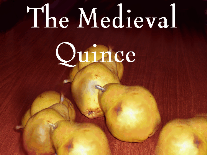MHDB Article ID: TMQ20040330
MHDB Article date: revised 3 October 2020; original date 30 March 2004
MHDB Article Author(s): Staff
 Perhaps one of the lesser-known of common medieval foods was the quince: a golden,
pear-shaped fruit often used in making preserves and jellies,
or "condoignac" - a jam-like paste made with quinces, honey, and
other ingredients that firms up into a gummy fruit candy.
Perhaps one of the lesser-known of common medieval foods was the quince: a golden,
pear-shaped fruit often used in making preserves and jellies,
or "condoignac" - a jam-like paste made with quinces, honey, and
other ingredients that firms up into a gummy fruit candy.
Joan of Arc was allegedly treated to a variation of the latter,
called "Condoignac d'Orléans", after lifting the siege. While this story
may be apocryphal, nevertheless the delicacy was held in
great esteem and purchased only at great expense, and was therefore a
fitting gift for Orleans' liberator.
A recipe for condoignac was included in the manuscript known as "Le Mesnagier de Paris". The recipe calls for peeling the quinces, then cutting them into fourths, removing the seeds, and cooking them in "good red wine" before straining the
result. After boiling honey "for a long time", the quinces were then placed in the honey and boiled while stirring until the depth of the honey reduced to 50%. Hypocras powder was then added, and the mixture was stirred until cool, which would produce a jelly-like substance which
was then sliced into sections.
A more common use for the quince during this period was in
more humble jams, since it contains large amounts of the pectin needed
for making jellied fruit. This was an important means of preserving
fruit for consumption out of season, a practice which has survived
in the modern continued habit of spreading jelly on bread and toast.
The quince factored in early marmalades, and in fact the term
itself derives from the Portuguese word for this golden fruit, "marmelo".
Quinces were additionally used in meat dishes, where their
tart flavor is a good offset to certain types of
meat. Dishes for quail, partridge, and the like could include quinces.
Quince pie was included in Chiquart's cookbook (15th century), which called for laying down a bottom crust, then taking quinces and cutting out the cores and placing the result on the crust, filling in the rest of the area with sugar (or in some variations, ginger or honey mixed with ginger and pepper),
then adding a top crust.
|